Hidden away, all throughout Florida, are places where it's possible to see what our State looked like hundreds, even thousands of years ago. On Tuesday our cadets got to visit one of these places as part of their Biology, Marine Science, and Environmental Science classes. We traveled past bustling cities, ribbon upon ribbon of highways, and thousands of people going about their workday. This was, not so much a journey away from Ocala, as it was a journey back through time. Humanity has touched virtually every part of this State and not always for the better. In places like Crystal Springs, some of the original Earth Magic still exists and for 6 hours, our students got to study in this place.

 The journey began with a slight chill in the air, but by the time we arrived, it was sunny and warm. Birds announced our arrival before, Sonya, the director of the Crystal Springs Foundation met us when the bus pulled in. She lead the students into the nature center as she explained that this spring was privately owned by one of the original cattle ranching families in Florida. In an effort to give back to the State, they set aside this 530-acre natural spring and surrounding habitat for students to learn about Florida.
The journey began with a slight chill in the air, but by the time we arrived, it was sunny and warm. Birds announced our arrival before, Sonya, the director of the Crystal Springs Foundation met us when the bus pulled in. She lead the students into the nature center as she explained that this spring was privately owned by one of the original cattle ranching families in Florida. In an effort to give back to the State, they set aside this 530-acre natural spring and surrounding habitat for students to learn about Florida.
The nature center is filled with the animals large and small that call Florida home. Sonya explained that every animal on the walls and shelves were once thriving and fell victim to cars. As part of their effort to protect Florida and show students what shares the state with them, they pick up road-killed animals and skin them out then display it for visitors.

In addition to this, they also maintain a healthy collection of animals that grace the preserve. Our students looked on in amazement as she pulled a juvenile alligator out of a tank and then let them handle it! Several cadets commented that they had never seen an alligator in the wild so this was doubly fascinating for them 

As she spoke, Sonya explained that as humans have encroached into the natural habitats of the other Floridians, it has forced them to adapt. The American alligator has bounced back from near extinction through an aggressive recovery program; still one of the most successful stories in environmental protection. She pointed out that there are still conflicts. People and their pets live in neighborhoods and gators move into their ponds creating a nuisance, when people start feeding them. "Cute" baby alligators soon learn that people walking dogs mean food and so they come closer for a tidbit tossed their way. That cute baby alligator lives it's life thinking this is their food source and soon becomes a 16-foot behemoth that those same people now fear. She pointed to an alligator skin mounted high on the wall of just such a tragic reminder.
After the nature center tour, we stepped out into the bright sunshine and into our classroom for the day. Natural Florida!
 We stopped in a limestone amphitheater fashioned from the bedrock of our state so Sonya could explain that this Spring provides water to South Florida via the Hillsborough River. Every day, without fail 300 million gallons of water boil up through the aquifer and combine with the headwaters of the Hillsborough to flow south and eventually into the Everglades.
We stopped in a limestone amphitheater fashioned from the bedrock of our state so Sonya could explain that this Spring provides water to South Florida via the Hillsborough River. Every day, without fail 300 million gallons of water boil up through the aquifer and combine with the headwaters of the Hillsborough to flow south and eventually into the Everglades. Following the brief hike, we got down to the science of water. Cadets learned what constitutes a healthy environment and what scientists look for to determine the health of a natural water system. Some cadets were surprised to realize that virtually 100% of the water we all drink comes from right beneath our feet! While there are very few organisms living in the aquifer itself, where it breaks through the surface to form the Springs system of the state, millions of species of insect, fish, bird, reptile, and others call these areas home. Students learned about water chemistry and where nitrates and nitrites come from as part of the aquatic nitrogen cycle.Some kids screwed their faces into strange shapes as they came to the realization that nitrates are actually formed from fish waste among other things and that they actually drink these. While some nitrates aren't bad, too many lead to an unhealthy system and result in an algae bloom which we've all seen.
Following the brief hike, we got down to the science of water. Cadets learned what constitutes a healthy environment and what scientists look for to determine the health of a natural water system. Some cadets were surprised to realize that virtually 100% of the water we all drink comes from right beneath our feet! While there are very few organisms living in the aquifer itself, where it breaks through the surface to form the Springs system of the state, millions of species of insect, fish, bird, reptile, and others call these areas home. Students learned about water chemistry and where nitrates and nitrites come from as part of the aquatic nitrogen cycle.Some kids screwed their faces into strange shapes as they came to the realization that nitrates are actually formed from fish waste among other things and that they actually drink these. While some nitrates aren't bad, too many lead to an unhealthy system and result in an algae bloom which we've all seen.
Our job for today, after learning about water chemistry and components of a healthy system such as dissolved oxygen and nitrates and nitrites, was to become water scientists and compare the water flowing from the headwaters of the Hillsborough River and the water flowing from the sand boils of Crystal Springs. 

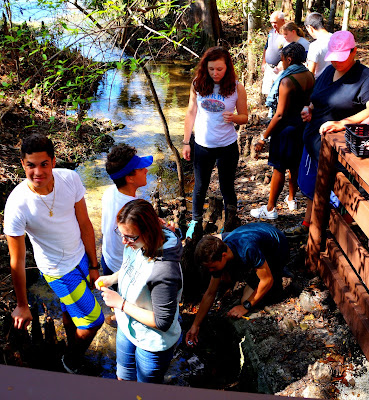 Nearby a juvenile alligator sunning itself on shore startled our intrepid scientists as it plopped into the water and swam away. Sonya pointed out that most of the time these Floridians hate company so swim away rather than stick around. It's only when mother gators have hatched out young that they become aggressive.
Nearby a juvenile alligator sunning itself on shore startled our intrepid scientists as it plopped into the water and swam away. Sonya pointed out that most of the time these Floridians hate company so swim away rather than stick around. It's only when mother gators have hatched out young that they become aggressive. A cadet takes the water temperature at a sand boil- a natural feature of a Florida spring where clean, cool water boils up from the aquifer.
A cadet takes the water temperature at a sand boil- a natural feature of a Florida spring where clean, cool water boils up from the aquifer.Cadets were broken down into teams and had to sample water and record their data before coming back together to discuss their results.
Students collect water samples from the sand boils; areas, where fresh water rushes up from it, 's long journey underground to burst forth forming a spring.
 Captain McCord explains some of the nuances of water testing and Florida's environment to his Environmental Science cadets.
Captain McCord explains some of the nuances of water testing and Florida's environment to his Environmental Science cadets. Mr. Spangler keeps the testing stations supplied with needed reagents- chemicals used to show some type of change int he presence of certain other substances.
Mr. Spangler keeps the testing stations supplied with needed reagents- chemicals used to show some type of change int he presence of certain other substances.Sonya explains some of the soft skills cadets need if they wish to pursue a career in water testing. This job is perfect for people who don't want to work in crowds. Many people start with a two-year degree laden with chemistry, biology, and environmental sciences. Most people go on to get a four- year degree. A strong work ethic is a definite requirement. You must be able to manage your time well, be organized, and diligent in your efforts. Typically you list of lakes, rivers, and other bodies of water will come to you through email and you are expected to finish your tasks daily. Sometimes you are provided a vehicle so a good driving record is a definite must. This is a definite special skill set and if you master them, you can go to almost any state and work for the department of natural resources, environmental protection agency or a host of city and county organizations. Salary will range from about $27,000- $57,000 per year. Most places offer health insurance, retirement plans, and uniform stipends. A few also offer you a vehicle, but you might have to go pick it up at the office and then load it and go.
After spending the morning performing water chemistry tests, it was on to do a biodiversity count at the confluence of the Hillsborough and the Spring.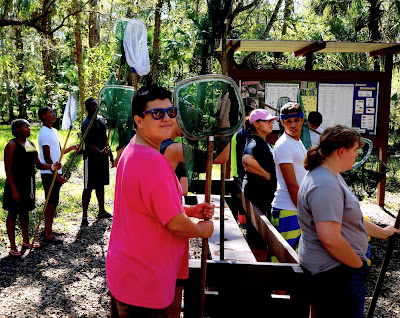 Students grabbed nets and learned what constitutes a healthy river. Not so much the quantity of an individual species but the presence of many different ones. Then, they waded into the water!
Students grabbed nets and learned what constitutes a healthy river. Not so much the quantity of an individual species but the presence of many different ones. Then, they waded into the water!
 Students grabbed nets and learned what constitutes a healthy river. Not so much the quantity of an individual species but the presence of many different ones. Then, they waded into the water!
Students grabbed nets and learned what constitutes a healthy river. Not so much the quantity of an individual species but the presence of many different ones. Then, they waded into the water!
The many faces of a cadet! LOL
Wwrapped up our afternoon by using a biodiverstity chart to count and identify the species we found in the water. 

A dragonfly dryad
 With a quick review we were off and headed back to Ocala. Students expressed how fun the day was and many said they now view rivers and springs in an entirely differnt way.
With a quick review we were off and headed back to Ocala. Students expressed how fun the day was and many said they now view rivers and springs in an entirely differnt way.































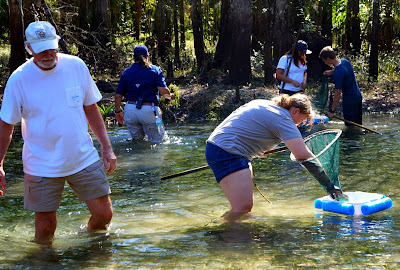







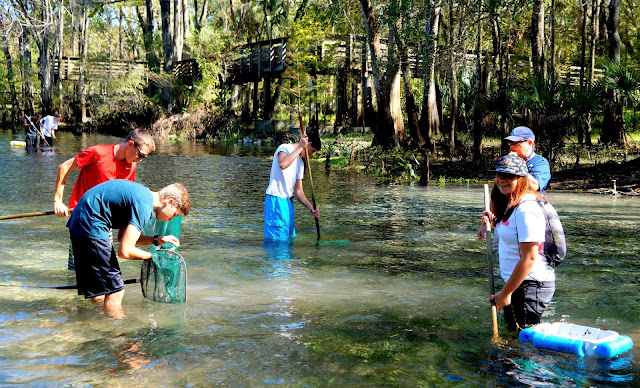







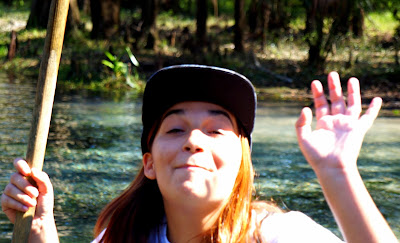






















No comments:
Post a Comment